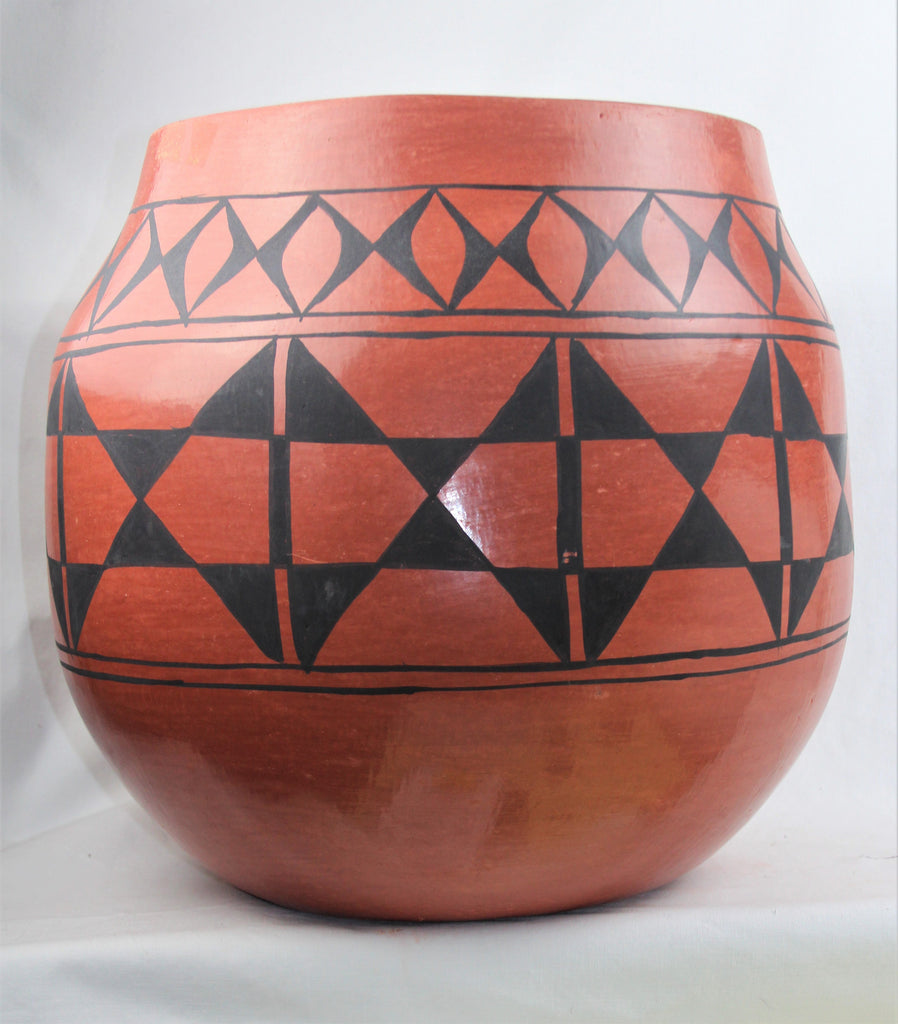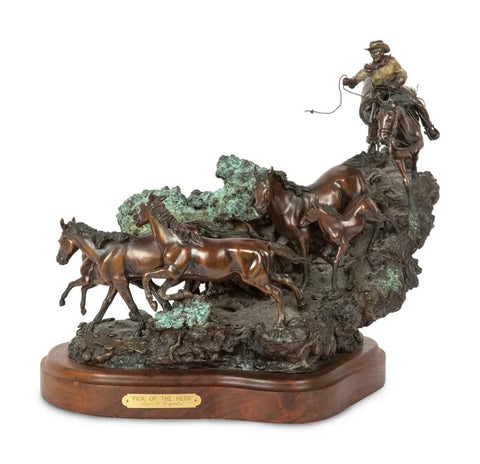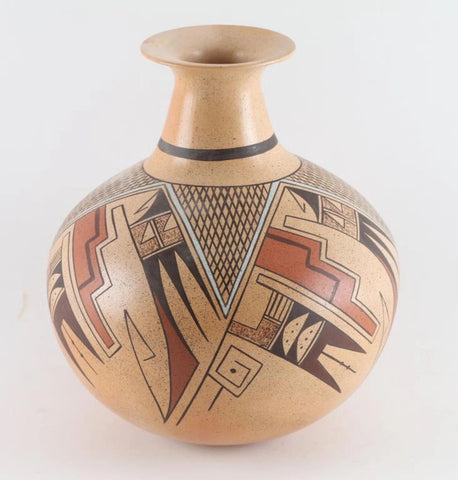
Native American Santo Domingo Red on Black, Large Storage Jar by Raphaelita Aguilar, Ca 1968, #1570 SOLD
$ 3,200.00
Native American Santo Domingo Red on Black, Large Storage Jar by Raphaelita Aguilar, Ca 1968, #1570
Discription: #1570 Native American Santo Domingo Red on Black, Large Storage Jar by Raphaelita Aguilar, Ca 1968. Signed original hand crafted Native American pottery vessel by Rafaelita Aguilar. Red clay vessel with stylized decoration in black. Artist signed Rafaelita Aguilar Santo Domingo Pueblo.
Dimensions: Vessel approximately 14 in. x 14 in.
Condition: Good condition with mild surface wear.
Rafaelita is from Kewa/Santo Domingo Pueblo and has been creating pottery since 1953 and follows the traditional methods for creating pottery of the Aguilar family which began in the early 1900’s. Rafaelita specializes in exceptionally large pottery vessels, which are stone-polished and pit-fired. She is the aunt of Robert Aguilar.
Exhibitions: 1994, Eight Northern Indian Pueblos Arts & Crafts shows; more than 20 years exhibiting in the Santa Domingo Pueblo Arts & Craft Show.
Collections: Roger & Marilyn Peterson, Williams Bay, WI; Dr. Gregory & Angie Schaaf, Santa Fe, N.M.; Bob & Carol Berray, Santa Fe, N.M.
Publications: Southern Pueblo Pottery 2000 Artist Biographies by Dr. Gregory Schaaf; Southwestern Pottery, by Allan Hayes & John Blom; Pueblo and Navajo Contemporary Pottery and Directory of Artists by Guy Berger and Nancy Schiffer (2000).
According to Dr. Schaaf “Rafaelita may be considered a relatively undiscovered master potter. Because she rarely entered her pots at Indian art shows, her work has not won ribbons. However, the quality of her work is commendable.” One of her favorite designs is four petal flowers. (Source: Two Ravens Pottery).
---------
“Pueblo pottery is made using a coiled technique that came into northern Arizona and New Mexico from the south, some 1500 years ago. In the four-corners region of the US, nineteen pueblos and villages have historically produced pottery. Although each of these pueblos use similar traditional methods of coiling, shaping, finishing and firing, the pottery from each is distinctive.
Various clay's gathered from each pueblo’s local sources produce pottery colors that range from buff to earthy yellows, oranges, and reds, as well as black. Fired pots are sometimes left plain and other times decorated—most frequently with paint and occasionally with appliqué. Painted designs vary from pueblo to pueblo, yet share an ancient iconography based on abstract representations of clouds, rain, feathers, birds, plants, animals and other natural world features.
Tempering materials and paints, also from natural sources, contribute further to the distinctiveness of each pueblo’s pottery. Some paints are derived from plants, others from minerals. Before firing, potters in some pueblos apply a light colored slip to their pottery, which creates a bright background for painted designs or simply a lighter color plain ware vessel. Designs are painted on before firing, traditionally with a brush fashioned from yucca fiber.
Different combinations of paint color, clay color, and slips are characteristic of different pueblos. Among them are black on cream, black on buff, black on red, dark brown and dark red on white (as found in Zuni pottery), matte red on red, and polychrome—a number of natural colors on one vessel (most typically associated with Hopi). Pueblo potters also produce undecorated polished black ware, black on black ware, and carved red and carved black wares.
Making pueblo pottery is a time-consuming effort that includes gathering and preparing the clay, building and shaping the coiled pot, gathering plants to make the colored dyes, constructing yucca brushes, and, often, making a clay slip. While some Pueblo artists fire in kilns, most still fire in the traditional way in an outside fire pit, covering their vessels with large potsherds and dried sheep dung. Pottery is left to bake for many hours, producing a high-fired result.
Today, Pueblo potters continue to honor this centuries-old tradition of hand-coiled pottery production, yet value the need for contemporary artistic expression as well. They continue to improve their style, methods and designs, often combining traditional and contemporary techniques to create striking new works of art.” (Source: Museum of Northern Arizona)
----------
View the other items in my shop: http://www.etsy.com/shop/CulturalPatina?ref=shopsection_shophome_leftnav
Discription: #1570 Native American Santo Domingo Red on Black, Large Storage Jar by Raphaelita Aguilar, Ca 1968. Signed original hand crafted Native American pottery vessel by Rafaelita Aguilar. Red clay vessel with stylized decoration in black. Artist signed Rafaelita Aguilar Santo Domingo Pueblo.
Dimensions: Vessel approximately 14 in. x 14 in.
Condition: Good condition with mild surface wear.
Rafaelita is from Kewa/Santo Domingo Pueblo and has been creating pottery since 1953 and follows the traditional methods for creating pottery of the Aguilar family which began in the early 1900’s. Rafaelita specializes in exceptionally large pottery vessels, which are stone-polished and pit-fired. She is the aunt of Robert Aguilar.
Exhibitions: 1994, Eight Northern Indian Pueblos Arts & Crafts shows; more than 20 years exhibiting in the Santa Domingo Pueblo Arts & Craft Show.
Collections: Roger & Marilyn Peterson, Williams Bay, WI; Dr. Gregory & Angie Schaaf, Santa Fe, N.M.; Bob & Carol Berray, Santa Fe, N.M.
Publications: Southern Pueblo Pottery 2000 Artist Biographies by Dr. Gregory Schaaf; Southwestern Pottery, by Allan Hayes & John Blom; Pueblo and Navajo Contemporary Pottery and Directory of Artists by Guy Berger and Nancy Schiffer (2000).
According to Dr. Schaaf “Rafaelita may be considered a relatively undiscovered master potter. Because she rarely entered her pots at Indian art shows, her work has not won ribbons. However, the quality of her work is commendable.” One of her favorite designs is four petal flowers. (Source: Two Ravens Pottery).
---------
“Pueblo pottery is made using a coiled technique that came into northern Arizona and New Mexico from the south, some 1500 years ago. In the four-corners region of the US, nineteen pueblos and villages have historically produced pottery. Although each of these pueblos use similar traditional methods of coiling, shaping, finishing and firing, the pottery from each is distinctive.
Various clay's gathered from each pueblo’s local sources produce pottery colors that range from buff to earthy yellows, oranges, and reds, as well as black. Fired pots are sometimes left plain and other times decorated—most frequently with paint and occasionally with appliqué. Painted designs vary from pueblo to pueblo, yet share an ancient iconography based on abstract representations of clouds, rain, feathers, birds, plants, animals and other natural world features.
Tempering materials and paints, also from natural sources, contribute further to the distinctiveness of each pueblo’s pottery. Some paints are derived from plants, others from minerals. Before firing, potters in some pueblos apply a light colored slip to their pottery, which creates a bright background for painted designs or simply a lighter color plain ware vessel. Designs are painted on before firing, traditionally with a brush fashioned from yucca fiber.
Different combinations of paint color, clay color, and slips are characteristic of different pueblos. Among them are black on cream, black on buff, black on red, dark brown and dark red on white (as found in Zuni pottery), matte red on red, and polychrome—a number of natural colors on one vessel (most typically associated with Hopi). Pueblo potters also produce undecorated polished black ware, black on black ware, and carved red and carved black wares.
Making pueblo pottery is a time-consuming effort that includes gathering and preparing the clay, building and shaping the coiled pot, gathering plants to make the colored dyes, constructing yucca brushes, and, often, making a clay slip. While some Pueblo artists fire in kilns, most still fire in the traditional way in an outside fire pit, covering their vessels with large potsherds and dried sheep dung. Pottery is left to bake for many hours, producing a high-fired result.
Today, Pueblo potters continue to honor this centuries-old tradition of hand-coiled pottery production, yet value the need for contemporary artistic expression as well. They continue to improve their style, methods and designs, often combining traditional and contemporary techniques to create striking new works of art.” (Source: Museum of Northern Arizona)
----------
View the other items in my shop: http://www.etsy.com/shop/CulturalPatina?ref=shopsection_shophome_leftnav
Related Products
Sold out









